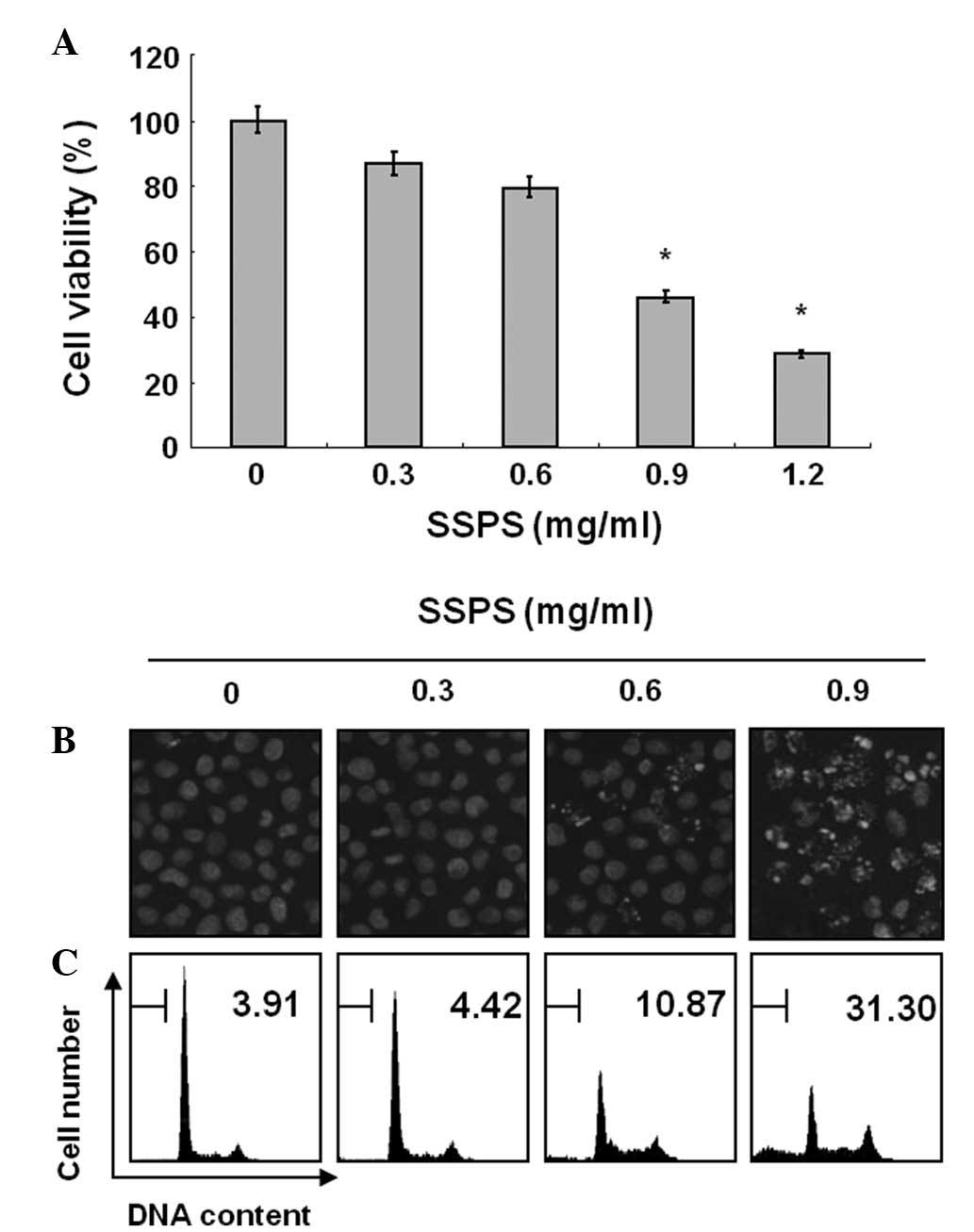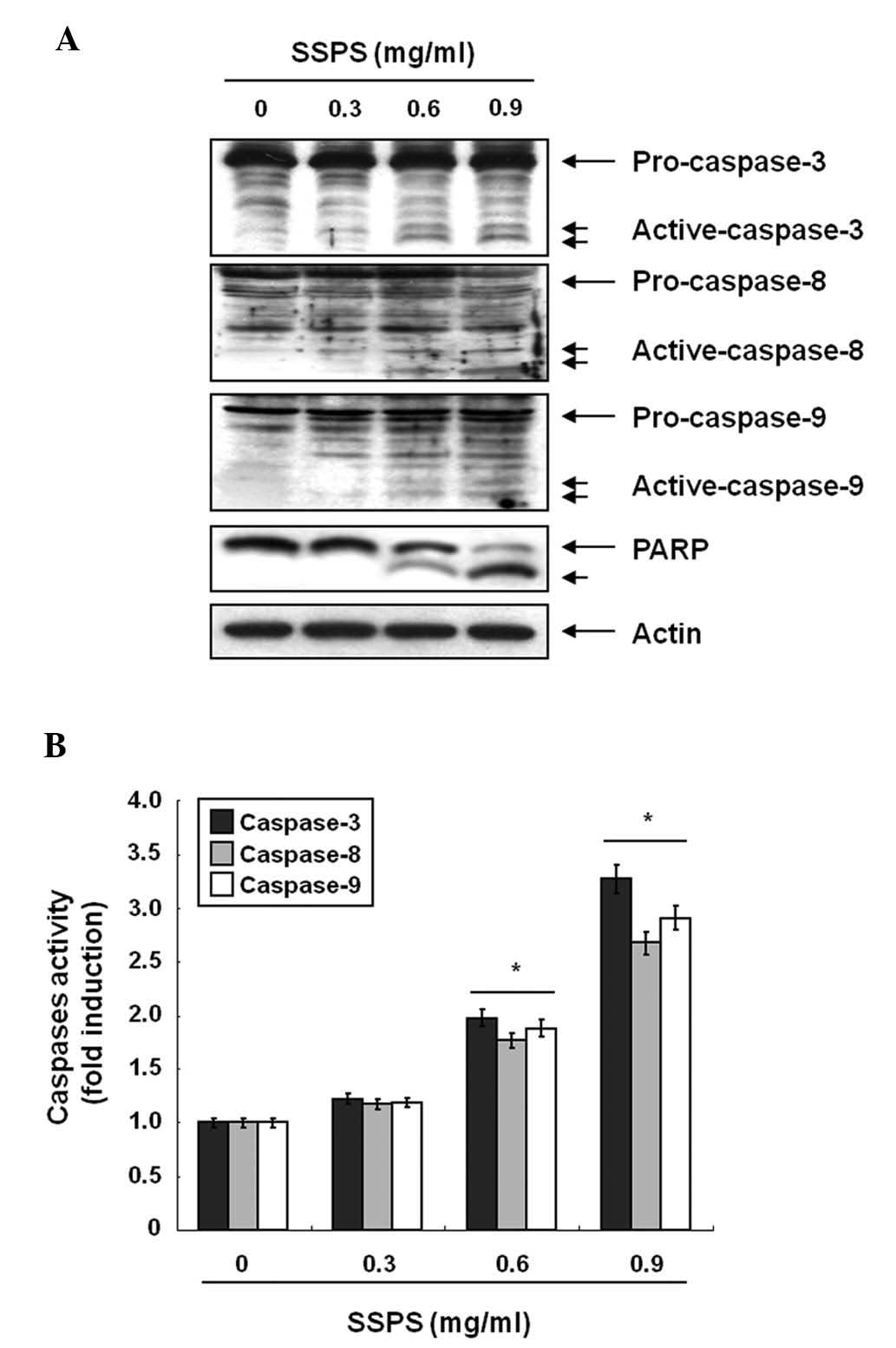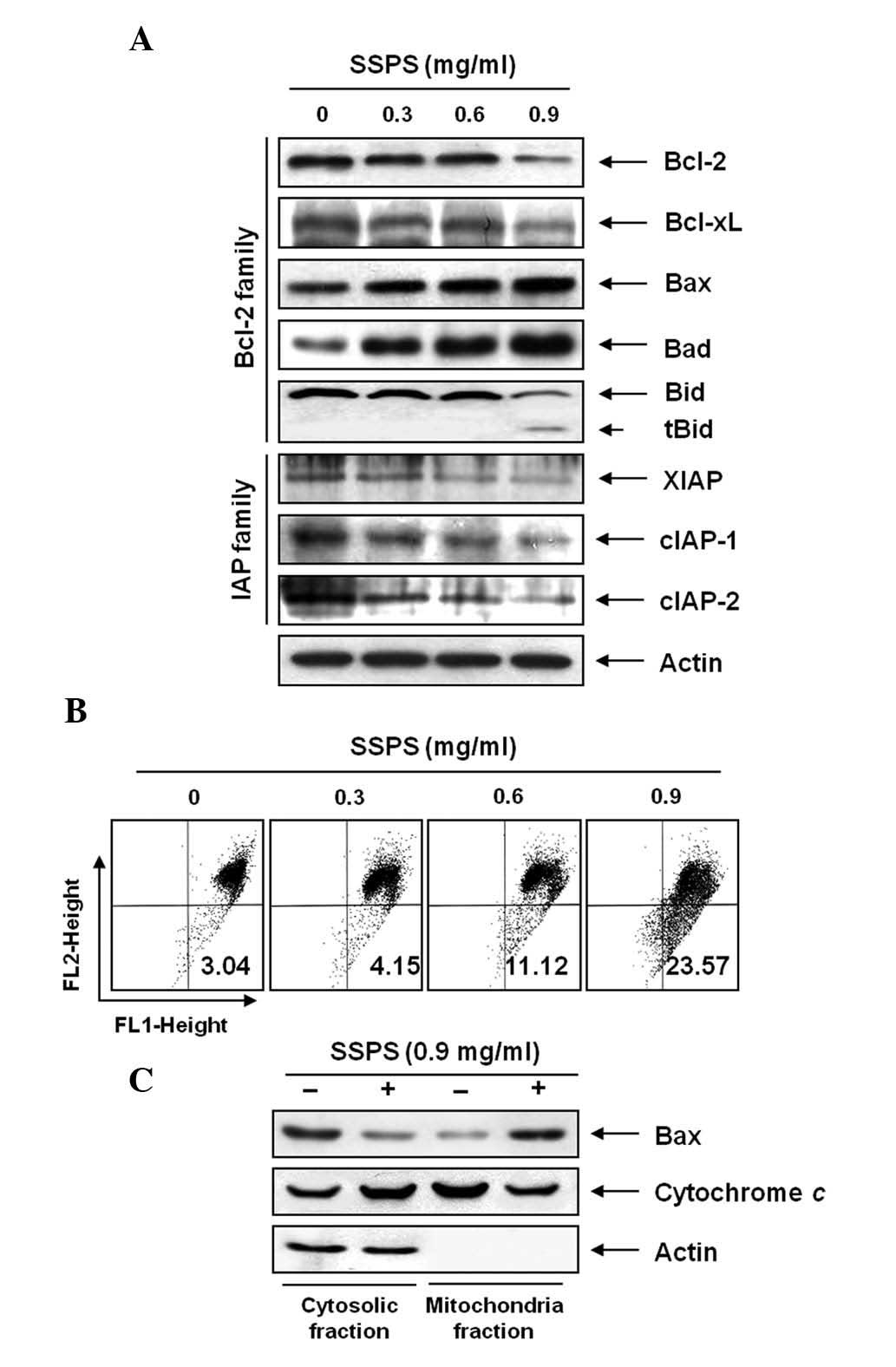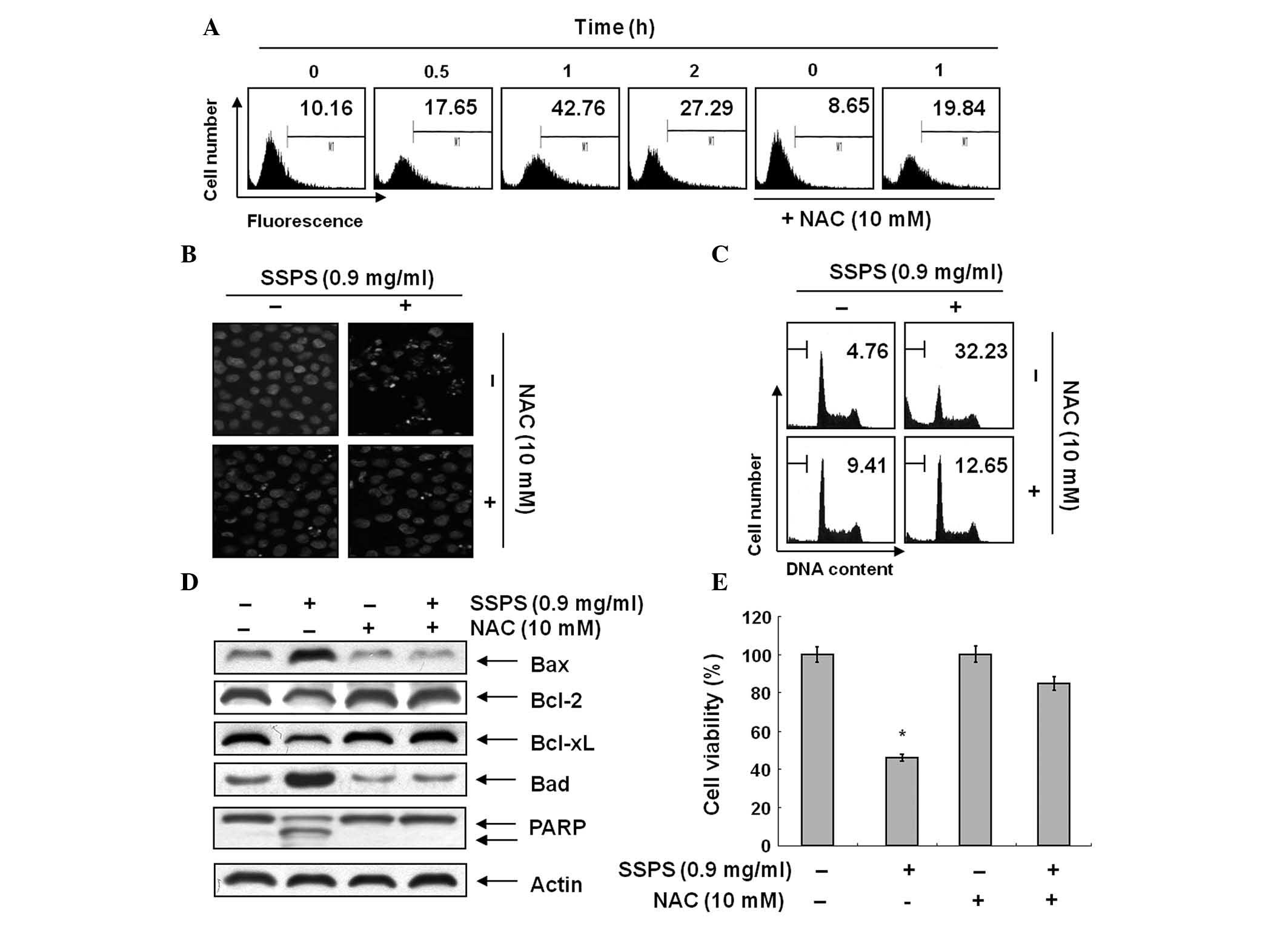Soy soluble polysaccharide induces apoptosis in HCT‑116 human colon cancer cells via reactive oxygen species generation
- Authors:
- Published online on: October 14, 2013 https://doi.org/10.3892/mmr.2013.1725
- Pages: 1767-1772
Abstract
Introduction
Apoptosis is the active process of programmed cell death, which occurs during a number of important physiological conditions and has become an area of extensive investigation in cancer research to eliminate precancerous and/or cancerous cells (1,2). Apoptosis is a tightly regulated process characterized by cell shrinkage, plasma membrane blebbing and chromatin condensation that is consistent with DNA cleavage in ladders (1,3). Caspase (a family of cysteine proteases) activation is often regulated by specific cellular factors, including members of the Bcl-2 family and/or the death receptor-related gene products (4). The inhibitor of the apoptosis protein (IAP) family proteins, X-linked IAP (XIAP), cellular inhibitor of apoptosis protein (cIAP)-1, cIAP-2 and survivin, by contrast, are endogenous inhibitors of apoptosis. However, the majority of cancer cells block apoptosis, which allows them to survive regardless of genetic and morphological transformations. Therefore, the induction of apoptotic cell death is an important mechanism underlying the effect of numerous anti-cancer drugs.
Reactive oxygen species (ROS) are important regulators of apoptosis. ROS production has been shown to be part of the signaling process, whereby a number of bioactive agents activate a cascade that functions to eliminate cancer cells (5,6). Accordingly, excessive generation of ROS has been shown to result in cell damage and initiate certain effects (7). Although ROS are important in cell signaling, extended elevated levels of ROS lead to severe damage to DNA, RNA and proteins, which eventually results in cell death via apoptotic or necrotic mechanisms (8). In addition, ROS may act as intracellular messengers that are induced by a diverse range of stimuli and trigger apoptosis (9).
With the growth of ecological movements, natural products have become more popular for the prevention or treatment of cancer. This has been paralleled by an increase in research focused on natural products. The biological activities of the polysaccharides isolated from mushrooms, fungi, yeasts, algae, lichens and plants have attracted increased attention in the biochemical and medical areas due to their immunomodulatory, anticancer and antitumor effects (10). A previous study indicated cytotoxic activity of the polysaccharide against human cancer cell lines and demonstrated that the polysaccharide derived from herbal medicine may induce cell apoptosis (11). A number of bioactive polysaccharides have been isolated from botanical sources, the majority of which are relatively nontoxic with no significant side effects (12).
Soy sauce is currently used as a liquid seasoning in cooking worldwide (13) and its various biological activities have been reported, including antioxidative (14), antiplatelet (15) activities and immunomodulatory effect (16) and the inhibition of angiotensin I-converting enzyme (17). Soy soluble polysaccharides (SPS) have been reported for hypoallergenicity and antiallergic activity, and be effective for allergic disorders. Therefore, soy sauce is considered to be not only a liquid seasoning but also a functional anti-cancer food (13,18). In the present study, SSPS was observed to induce a number of characteristic apoptotic symptoms in HCT-116 human colon cancer cells, including chromatin condensation, activation of caspases, cleavage of poly ADP-ribose polymerase (PARP) and mitochondrial depolarization. ROS were shown to be potential causes of the caspase activation that leads to SSPS-induced apoptosis.
Materials and methods
Reagents
4,6-diamidino-2-phenylindole (DAPI), N-acetyl-L-cysteine (NAC), 3-(4,5-dimethylthiazol-2-yl)-2,5-diphenyl diphenyl-tetrazolium bromide (MTT) and propidium iodide (PI) were purchased from the Sigma-Aldrich (St. Louis, MO, USA). The caspase inhibitors z-DEVD-fmk (caspase-3 inhibitor), z-IETD-fmk (caspase-8 inhibitor), z-LEHD-fmk (caspase-9 inhibitor) and 5,5′,6,6′-tetrachloro-1,1′,3,3′-tetraethyl-imidacarbocyanine iodide (JC-1) were purchased from Calbiochem (San Diego, CA, USA). Mouse monoclonal antibodies Bcl-2, Bad, caspase-3, actin and rabbit polyclonal antibodies against Bcl-xL, Bax, Bid, cytochrome c, caspase-8, caspase-9, XIAP, cIAP-1, cIAP-2 and PARP were purchased from Santa Cruz Biotechnology, Inc. (Santa Cruz, CA, USA). The peroxidase-labeled donkey anti-rabbit immunoglobulin and peroxidase-labeled sheep anti-mouse immunoglobulin were purchased from Amersham Pharmacia Biotech (Piscataway, NJ, USA).
Preparation of soy sauce
Fermented soybean, a seed for soy sauce, was prepared by multi-step fermentation (19). Soy sauce was fermented and aged using fermented soybean. The prepared Meju was mixed with a brine solution (20%) at a ratio of 1:2 (w/v) and was placed in individual cylindrical mash tanks. Throughout the aging process, the temperature was maintained at 15°C. The total aging period was three months.
Isolation and preparation of SSPS
SSPS were prepared according to the method described previously by Kikuchi et al(20). Soy sauce (10 ml) was dialyzed overnight using seamless cellulose tubing [width, 43 mm; diameter 27 mm; 12,000 MW; dialysis membrane (Viskase Companies, Inc., Darien, IL, USA)] in water at 4°C and freeze-dried.
Cell line, cell culture and MTT assay
HCT-116 human colon cancer cells were obtained from the American Type Culture Collection (Rockville, MD, USA) and cultured in RPMI-1640 supplemented with 10% fetal bovine serum and 1% penicillin-streptomycin at 37°C in a humidified chamber containing 95% air and 5% CO2. For the cell viability assay, cells were cultured in the absence and presence of various concentrations of SSPS for 24 h. Measurement of cell viability was determined using the MTT assay, which is based on the conversion of MTT to MTT-formazan by mitochondrial enzymes.
Flow cytometry analysis
Following treatment with SSPS, the cells were collected, washed with cold phosphate-buffered saline (PBS) and fixed in 75% ethanol at 4°C for 30 min. Prior to analysis, the cells were washed once with PBS, suspended in a cold PI solution containing 100 μg/ml RNase A, 50 μg/ml PI, 0.1% (w/v) sodium citrate and 0.1% (v/v) NP-40 and incubated on ice for 30 min in the dark. Flow cytometry analyses were conducted using a flow cytometer (FACSCalibur; BD Biosciences, San Jose, CA, USA). Cell-Quest software was used to determine the relative DNA content based on the presence of red fluorescence. The sub-G1 population was calculated to estimate the apoptotic cell population (21).
DAPI staining
Cells were washed with ice-cold PBS and fixed with 4% paraformaldehyde (Sigma-Aldrich) in PBS for 10 min at room temperature. Fixed cells were washed with PBS and stained with DAPI solution for 10 min at room temperature. The cells were washed twice with PBS and analyzed by fluorescence microscopy (EM-900; Carl Zeiss AG, Oberkochen, Germany).
Determination of caspase activity
The enzymatic activity of the caspases induced by SSPS was assayed using a colorimetric assay kit (R&D Systems, Minneapolis, MN, USA) according to manufacturer’s instructions. Briefly, cells were lysed in the supplied lysis buffer. The lysed cells were centrifuged at 20,000 × g for 20 min, and equal amounts of protein (100 μg per 50 μl) were incubated with 50 μl of a reaction buffer and 5 μl of the colorimetric tetrapeptides, Asp-Glu-Val-Asp (DEVD)-p-nitroaniline (pNA) for caspase-3, Ile-Glu-Thr-Asp (IETD)-pNA for caspase-8 and Leu-Glu-His-Asp (LEHD)-pNA for caspase-9, respectively. Caspase activity was determined by measuring changes in absorbance at 405 nm using the enzyme-linked immunosorbent assay reader.
Protein extraction and western blot analysis
Cells were harvested and lysed with lysis buffer (20 mM sucrose, 1 mM EDTA, 20 μM Tris-HCl, pH 7.2, 1 mM DTT, 10 mM KCl, 1.5 mM MgCl2 and 5 μg/ml aprotinin) for 30 min. The protein concentration was measured using a Bio-Rad protein assay (Bio-Rad, Hercules, CA, USA). For western blot analysis, an equal quantity of protein was subjected to electrophoresis on sodium dodecyl sulfate (SDS)-polyacrylamide gel and transferred to a nitrocellulose membrane (Schleicher & Schuell, Inc., Keene, NH, USA). Blots were probed with the desired antibodies for 1 h, incubated with the diluted enzyme-linked secondary antibody and visualized by enhanced chemiluminescence according to the manufacturer’s instructions (Amersham Pharmacia Biotech).
Mitochondrial membrane potential (MMP, Δψm) assay
The MMP was determined using the lipophilic cationic probe JC-1. JC-1 is a radiometric, dual-emission fluorescent dye that is absorbed and concentrated by respiring mitochondria and can reflect changes in MMP in living cells. There are two excitation wavelengths, 527 nm (green) for the monomer form and 590 nm (red) for the JC-1-aggregate form. With normal mitochondrial function, MMP is high and red fluorescence is predominant. However, when there is mitochondrial injury, the MMP is reduced, leading to an increase in green fluorescence. The relative intensity of red and green fluorescent signals indicate whether mitochondria are damaged. In the current study, cells were trypsinized and cell pellets were resuspended in PBS and incubated with 10 μM JC-1 for 20 min at 37°C. Cells were analyzed using flow cytometry.
Preparation of mitochondrial proteins
Cells were treated with SSPS and harvested with ice-cold PBS. The mitochondrial and cytosolic fractions were isolated using a mitochondrial fractionation kit according to the manufacturer’s instructions (Active Motif, Carlsbad, CA, USA). Cell lysates (30 μg protein/lane) were fractionated in SDS-polyacrylamide gels prior to transfer to the nitrocellulose membranes (Schleicher & Schuell) using standard instructions.
Measurement of intracellular ROS generation
Generation of ROS was determined in cells treated with SSPS in the presence and absence of NAC and was evaluated with 20,70-dichlorofluorescein diacetate (DCF-DA; Molecular Probes, Leiden, The Netherlands) as described previously (22). Cells were incubated with 10 μM DCF-DA at 37°C for 30 min, washed with PBS and FL-1 fluorescence was measured by flow cytometery.
Statistical analysis
The data are expressed as the mean ± SD. A statistical comparison was performed using one-way analysis of variance followed by Fisher’s exact test. The significant differences between the groups were determined using unpaired Student’s t-test. P<0.05 was considered to indicate a statistically significant difference.
Results
Inhibition of cell growth and induction of apoptosis by SSPS in HCT-116 cells
To investigate the effect of SSPS on the cell growth of HCT-116 cells, cells were exposed to specific concentrations (0, 0.3, 0.6, 0.9 and 1.2 mg/ml) of SSPS. Following 24 h incubation, the cell viability was measured using an MTT assay. As shown in Fig. 1A, treatment with SSPS significantly inhibited the viability of cells and these effects occurred in a concentration-dependent manner.
To elucidate whether SSPS inhibits the viability of HCT-116 cells by inducing apoptosis, cells treated with SSPS were examined following DAPI staining. The control cells exhibited an intact nuclear structure, whereas, cells treated with SSPS had chromosomal condensation and formation of apoptotic bodies (Fig. 1B). Morphological analysis of HCT-116 cells treated with SSPS indicated that the cells had undergone gross morphological changes indicative of apoptosis, including chromatin condensation and formation of apoptotic bodies.
Thus, to assess how SSPS affected cell growth, the degree of apoptosis was determined by analyzing the quantity of sub-G1 DNA in HCT-116 cells that were treated with SSPS using flow cytometry. As shown in Fig. 1C, a significant accumulation of cells with sub-G1 DNA content was noted in a dose-dependent manner, but no other markedly detectable cell cycle changes were observed in HCT-116 cells treated with the indicated concentration of SSPS for 24 h. These results demonstrated that the cytotoxic effects observed in SSPS-treated HCT-116 cells are associated with the induction of apoptosis.
Caspase involvement in SSPS-induced apoptosis
Caspases are known to serve as important mediators of apoptosis and to contribute to the general apoptotic morphology through the cleavage of various cellular substrates, including PARP, an endogenous substrate of caspase-3 (23). Therefore, the expression levels and activities of caspase-3, -8 and -9 during SSPS-induced apoptosis were investigated. As shown in Fig. 2A, western blot analyses showed that SSPS concentration dependently induced a marked change in the cleavage of caspase-3, -8 and -9. Subsequent western blot analyses showed the progressive proteolytic cleavage of PARP in HCT-116 cells following SSPS treatment, indicating that the activation of caspase is involved in the SSPS-induced apoptotic pathway. To further quantify the proteolytic activation of caspases in HCT-116 cells, the lysates normalized for protein from the cells treated with SSPS were assayed for their activities using colorimetric assay kits. As shown in Fig. 2B, treatment with SSPS significantly increased the activities of caspase-3, -8 and 9 compared with control cells.
Effects of SSPS on the expression of Bcl-2 and IAP family proteins and a loss of MMP (Δψm) in HCT-116 cells
The involvement of Bcl-2 and IAP family proteins in SSPS-mediated apoptosis was determined by western blot analysis. As shown in Fig. 3A, when HCT-116 cells were treated with SSPS, a marked decrease in Bcl-2 and Bcl-xL antiapoptotic protein expression was observed in a concentration-dependent manner. In the case of the proapoptotic proteins Bax and Bad, there was a marginal concentration-dependent upregulation observed in HCT-116 cells treated with SSPS. In addition, western blot analyses revealed that treatment with SSPS induced the cleavage of Bid, generating a truncated form, tBid, a Bcl-2 homology domain (BH)-3-only proapoptotic member of the Bcl-2 family. The levels of XIAP, cIAP-1 and cIAP-2 were markedly inhibited by SSPS treatment, in a concentration dependent manner.
Furthermore, the involvement of the mitochondria in SSPS-induced apoptosis of HCT-116 cells was investigated by examining the effect of SSPS on the MMP values as well as the levels of cytosolic and mitochondrial Bax and cytochrome c. As shown in Fig. 3B, exposure of HCT-116 cells to various concentrations of SSPS led to a significant reduction in the level of MMP and this reduction occurred in a dose-dependent manner. In addition, exposure of HCT-116 cells to SSPS led to a significant increase in the level of cytosolic proapoptotic protein cytochrome c and to the decrease of Bax (Fig. 3C). By contrast, treatment with SSPS induced a significant downregulation of cytochrome c and upregulation of Bax protein in the mitochondria. These results indicate that SSPS induced mitochondrial dysfunction in HCT-116 cells.
SSPS-induced apoptosis is associated with the generation of ROS
SSPS was investigated to determine whether it may stimulate ROS generation in HCT-116 cells. In HCT-116 cells exposed to SSPS for the indicated time periods, generation of ROS was observed at 0.5 h and the levels continued to increase at 1 h (Fig. 4A). The ROS scavenger NAC at 10 mM significantly blocked the levels of ROS from the SSPS-treated HCT-116 cells. NAC scavenges ROS in cells by interacting with OH− and H2O2 and thus affect ROS-mediated signaling pathways (24). As shown in Fig. 4B and C, pretreatment of HCT-116 cells with NAC attenuated chromatin condensation and formation of apoptotic bodies and restored the accumulation of the sub-G1 DNA population. In addition, blocking of the generation of ROS by pretreatment of the cells with NAC prevented the SSPS-induced modulation of Bcl-2 family proteins and the cleavage of PARP (Fig. 4D). Inhibiting the generation of ROS by pretreatment of the cells with NAC significantly prevented the SSPS-induced loss of cell viability (Fig. 4E).
Discussion
In 1972, Kikuchi and Yokotsuka (25) purified polysaccharides from soy sauce and investigated their properties in detail. Polysaccharides obtained from soybeans, one of the predominant raw materials of soy sauce, contained a large quantitiy of galacturonic acid and were marginally hydrolyzed by mold enzymes (20,25). Matsushita et al(16) and Kobayashi et al(26) reported immunomodulatory and anti-allergic activities of Shoyu polysaccharides from soy sauce; however, the cellular and molecular mechanisms responsible for the apoptotic effects of SSPS have not yet been determined in cancer cells. In the current study, the inhibition of cell viability was investigated by SSPS, and the concentration-dependent changes in the chromatin condensation of nuclei were determined using HCT-116 cells.
Apoptosis is mediated via the activation of an extrinsic (death receptor-mediated) or intrinsic (mitochondrial-mediated) pathway, regulated by caspases, death receptors and the Bcl-2 family (27). Mitochondrial dysfunction, including the loss of MMP (Δψm), which is accompanied by the alteration of Bcl-2 family proteins (28) and release of cytochrome c from the mitochondria into the cytosol is associated with apoptosis (29). Bid is a member of the BH-3-only family of proapoptotic proteins that initiate apoptotic cell death. During death receptor-induced apoptosis, Bid is activated through cleavage by caspase-8, generating a truncated form, tBid. tBid and Bax cooperate to induce mitochondrial dysfunction, including cytochrome c release (23). The IAP family proteins reportedly block apoptosis due to their function as direct inhibitors that bind to and inhibit a number of caspases (30). In the current study, SSPS-induced apoptosis was shown to associate with a decrease in Bcl-2 and cleavage of Bid. Furthermore, expression levels of the XIAP proteins were decreased by SSPS (Fig. 2). Caspases are known to act as important mediators of apoptosis and to contribute to the overall apoptotic morphology via the cleavage of specific cellular substrates. In particular, activation of caspase-3 is responsible for the proteolytic degradation of a number of key proteins, including PARP, finally leading to apoptosis (31). The present results indicate that SSPS treatment induces activation of caspase-3, -8 and -9 and concomitant proteolytic degradation and downregulation of PARP proteins.
ROS have been shown to induce specific biological processes, including apoptosis. Increased ROS induces the collapse of MMP therefore triggering a series of mitochondria-associated events, including apoptosis (8). Overproduction of ROS was observed in SSPS-treated cells and the SSPS-induced cell death was prevented by the antioxidant NAC, indicating that ROS generation is involved in the SSPS-induced apoptosis in HCT-116 cells.
In the present study, treatment with the natural substance SSPS was shown to lead to increased apoptosis in the human colon cancer cell line. The results demonstrate that SSPS may significantly induce apoptosis in HCT-116 cells through a mitochondria-mediated caspase pathway and ROS generation. The results obtained in the present study show that SSPS may contribute to the prevention or treatment of colorectal cancer.
References
|
Ghobrial IM, Witzig TE and Adjei AA: Targeting apoptosis pathways in cancer therapy. CA Cancer J Clin. 55:178–194. 2005. View Article : Google Scholar : PubMed/NCBI | |
|
Han SI, Kim YS and Kim TH: Role of apoptotic and necrotic cell death under physiologic conditions. BMB Rep. 41:1–10. 2008. View Article : Google Scholar : PubMed/NCBI | |
|
Makin G and Dive C: Apoptosis and cancer chemotherapy. Trends Cell Biol. 11:S22–S26. 2001. View Article : Google Scholar : PubMed/NCBI | |
|
Nagata S and Golstein P: The Fas death factor. Science. 267:1449–1456. 1995. View Article : Google Scholar | |
|
Ka H, Park HJ, Jung HJ, et al: Cinnamaldehyde induces apoptosis by ROS-mediated mitochondrial permeability transition in human promyelocytic leukemia HL-60 cells. Cancer Lett. 196:143–152. 2003. View Article : Google Scholar | |
|
Ueda S, Nakamura H, Masutani H, et al: Baicalin induces apoptosis via mitochondrial pathway as prooxidant. Mol Immunol. 38:781–791. 2002. View Article : Google Scholar : PubMed/NCBI | |
|
Davies KJ and Hochstein P: Ubisemiquinone radicals in liver: implications for a mitochondrial Q cycle in vivo. Biochem Biophys Res Commun. 107:1292–1299. 1982. View Article : Google Scholar : PubMed/NCBI | |
|
Fiers W, Beyaert R, Declercq W and Vandenabeele P: More than one way to die: apoptosis, necrosis and reactive oxygen damage. Oncogene. 18:7719–7730. 1999. View Article : Google Scholar : PubMed/NCBI | |
|
Chakraborti T, Das S, Mondal M, Roychoudhury S and Chakraborti S: Oxidant, mitochondria and calcium: an overview. Cell Signal. 11:77–85. 1999. View Article : Google Scholar : PubMed/NCBI | |
|
Lu X, Liu W, Wu J, et al: A polysaccharide fraction of adlay seed (Coixlachryma-jobi L.) induces apoptosis in human non-small cell lung cancer A549 cells. Biochem Biophys Res Commun. 430:846–851. 2013.PubMed/NCBI | |
|
Chow LW, Lo CS, Loo WT, Hu XC and Sham JS: Polysaccharide peptide mediates apoptosis by up-regulating p21 gene and down-regulating cyclin D1 gene. Am J Chin Med. 31:1–9. 2003. View Article : Google Scholar : PubMed/NCBI | |
|
Jeong SC, Yang BK, Ra KS, et al: Characteristics of anti-complementary biopolymer extracted from Coriolus versicolor. Carbohydr Polym. 55:255–263. 2004. View Article : Google Scholar | |
|
Kataoka S: Functional effects of Japanese style fermented soy sauce (shoyu) and its components. J Biosci Bioeng. 100:227–234. 2005. View Article : Google Scholar : PubMed/NCBI | |
|
Long LH, Kwee DC and Halliwell B: The antioxidant activities of seasonings used in Asian cooking. Powerful antioxidant activity of dark soy sauce revealed using the ABTS assay. Free Radic Res. 32:181–186. 2000. View Article : Google Scholar : PubMed/NCBI | |
|
Tsuchiya H, Sato M and Watanabe I: Antiplatelet activity of soy sauce as functional seasoning. J Agric Food Chem. 47:4167–4174. 1999. View Article : Google Scholar : PubMed/NCBI | |
|
Matsushita H, Kobayashi M, Tsukiyama R and Yamamoto K: In vitro and in vivo immunomodulating activities of Shoyu polysaccharides from soy sauce. Int J Mol Med. 17:905–909. 2006.PubMed/NCBI | |
|
Kinoshita E, Yamakoshi J and Kikuchi M: Purification and identification of an angiotensin I-converting enzyme inhibitor from soy sauce. Biosci Biotechnol Biochem. 57:1107–1110. 1993. View Article : Google Scholar : PubMed/NCBI | |
|
Kobayashi M: Immunological functions of soy sauce: hypoallergenicity and antiallergic activity of soy sauce. J Biosci Bioeng. 100:144–151. 2005. View Article : Google Scholar : PubMed/NCBI | |
|
Lee JO, Park MH, Choi YH, Ha YL and Ryu CH: New fermentation technique for complete digestion of soybean protein. J Microbiol Biotechnol. 17:1904–1907. 2007.PubMed/NCBI | |
|
Kikuchi T and Sugimoto H: Detailed structure of an acidic polysaccharide in soy sauce, confirmed by use of two kinds of purified pectinases. Agric Biol Chem. 40:87–92. 1975. View Article : Google Scholar | |
|
Jung EJ, Kim CW and Kim DR: Cytosolic accumulation of gammaH2AX is associated with tropomyosin-related kinase A-induced cell death in U2OS cells. Exp Mol Med. 40:276–285. 2008. View Article : Google Scholar : PubMed/NCBI | |
|
Shin DY, Kim GY, Li W, et al: Implication of intracellular ROS formation, caspase-3 activation and Egr-1 induction in platycodon D-induced apoptosis of U937 human leukemia cells. Biomed Pharmacother. 63:86–94. 2009. View Article : Google Scholar : PubMed/NCBI | |
|
Jeong JW, Jin CY, Park C, et al: Induction of apoptosis by cordycepin via reactive oxygen species generation in human leukemia cells. Toxicol In Vitro. 25:817–824. 2011. View Article : Google Scholar : PubMed/NCBI | |
|
Moon DO, Kim MO, Choi YH, Hyun JW, Chang WY and Kim GY: Butein induces G(2)/M phase arrest and apoptosis in human hepatoma cancer cells through ROS generation. Cancer Lett. 288:204–213. 2010. View Article : Google Scholar : PubMed/NCBI | |
|
Kikuchi T and Yokotsuka T: Studies on the polysaccharides from soy sauce Part I. Agric Biol Chem. 36:544–550. 1972. View Article : Google Scholar | |
|
Kobayashi M, Matsushita H, Yoshida K, Tsukiyama R, Sugimura T and Yamamoto K: In vitro and in vivo anti-allergic activity of soy sauce. Int J Mol Med. 14:879–884. 2004.PubMed/NCBI | |
|
Tsujimoto Y: Cell death regulation by the Bcl-2 protein family in the mitochondria. J Cell Physiol. 195:158–167. 2003. View Article : Google Scholar : PubMed/NCBI | |
|
Kroemer G and Reed JC: Mitochondrial control of cell death. Nat Med. 6:513–519. 2000. View Article : Google Scholar | |
|
Green DR: Apoptotic pathways: ten minutes to dead. Cell. 121:671–674. 2005. View Article : Google Scholar : PubMed/NCBI | |
|
Gao Z, Tian Y, Wang J, et al: A dimeric Smac/diablo peptide directly relieves caspase-3 inhibition by XIAP. Dynamic and cooperative regulation of XIAP by Smac/Diablo. J Biol Chem. 282:30718–30727. 2007. View Article : Google Scholar : PubMed/NCBI | |
|
Lazebnik YA, Kaufmann SH, Desnoyers S, Poirier GG and Earnshaw WC: Cleavage of poly(ADP-ribose) polymerase by a proteinase with properties like ICE. Nature. 371:346–347. 1994. View Article : Google Scholar : PubMed/NCBI |













